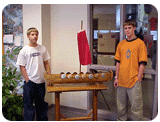


A rural school located at the northern tip of the Upper Peninsula of Michigan. Roper serves 244 students, of which 5% are in special education part-time. Thirty three percent of Roper’s students receive free or reduced-price lunch (the figure for students at the elementary level is 49.7%; according to the principal, free-lunch eligibility is under-reported at the secondary level. He estimates the actual eligibility to be similar to the elementary level). Roper has participated in the School Self-Assessment project since 1999 and hosted an external review in spring 2000.
AED documented Roper’s self-assessment efforts from 1999 to 2002. In this period, Roper set goals focused on improving student behavior, literacy, higher-order thinking skills, and use of technology in learning. Roper’s staff held retreats and professional development sessions to develop instructional strategies fostering improved literacy and higher-order thinking. These efforts contributed to improved student performance on the MEAP test.

Through the self-assessment network, the Roper principal and staff have engaged in meaningful exchanges with other SSA schools in the state. Roper is situated in a remote region in the Upper Peninsula, and such networking has helped the school draw on the experiences of other schools in making critical changes that influence teaching and learning. The principal described the work with the SSA project as “our school improvement process. Self-assessment and school improvement don't need to be separate. It's really helped us pull everything together in one very focused package.”
Both Hope and Roper had strong principal leadership and teacher support of self-assessment; they also faced similar challenges in implementing the project. Both needed to set aside significant amounts of time (a limited commodity) for the ongoing teacher discussions and professional development, for example a two-day summer retreat (Roper) and regularly scheduled faculty study groups (Hope). New school improvement and professional development initiatives from the district also competed for the limited time of the principal and staff. Despite this obstacle, both schools are well on their way to becoming strong learning environments for students.

